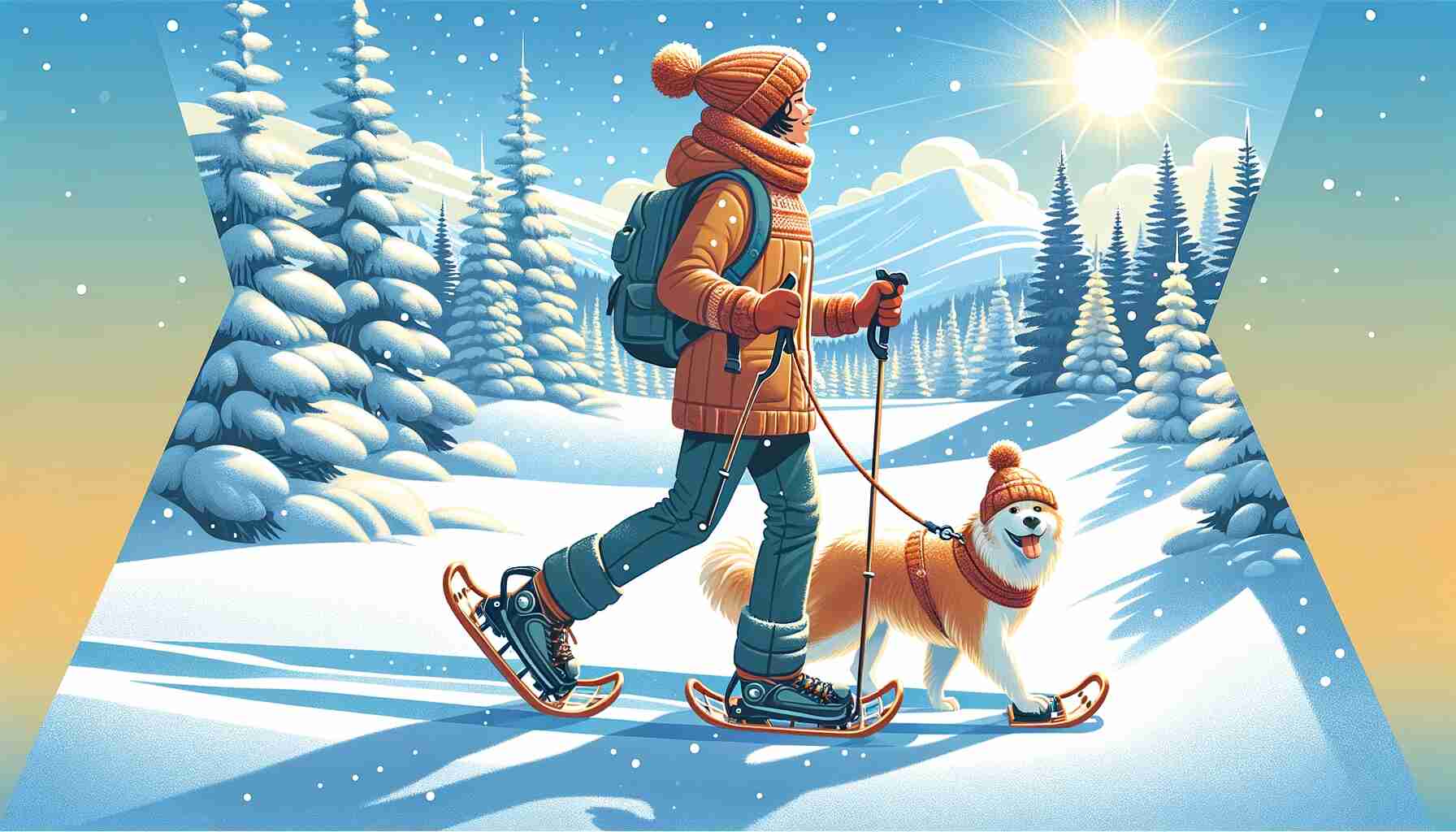Snowshoeing is a low-impact activity suitable for people of all ages and fitness levels. It provides an excellent cardiovascular workout and allows you to connect with nature in a tranquil winter setting. Plus, it’s relatively inexpensive compared to other winter sports, making it accessible to many. Now, let’s get to the heart of the matter: can dogs go snowshoeing?
Absolutely, you can go snowshoeing with your dog, and it’s a wonderfully rewarding experience for both of you. It offers a chance for exercise, adventure, and doesn’t demand as much training as some other winter activities. But, there are essential things to keep in mind.
Throughout this guide, we will explore the gear you’ll need, how to prepare your dog for snowshoeing, where to go, and how to ensure the safety and well-being of both you and your canine companion during your snowy adventures.
Table of Contents
TogglePreparation for Snowshoeing with Your Dog
What You’ll Need for Snowshoeing with Your Dog
To embark on a successful snowshoeing adventure with your dog, you’ll need the right gear. Here’s a breakdown of the essential equipment:
For You:
- Snowshoes: Choose the right size and style based on your weight and the terrain you’ll be covering.
- Poles: These provide balance and support while snowshoeing.
- Appropriate Clothing: Dress in layers to stay warm and dry, and don’t forget a good pair of waterproof boots.
- Safety Gear: Carry essential safety items like a map, compass, first-aid kit, and a multi-tool.
- Leash: Ensure you have a sturdy leash to keep your dog under control when necessary.
For Your Dog:
- Dog-Friendly Harness: Invest in a comfortable, well-fitting harness for your dog to attach the leash to. Avoid attaching the leash to a collar, as it can strain the neck during sudden movements.
- Dog Footwear: Protect your dog’s paws from cold and sharp objects with booties designed for snow. Make sure they fit properly and allow your dog to walk comfortably.
- Reflective Vest: If you’ll be snowshoeing in low-light conditions, consider a reflective vest for your dog to enhance visibility.
- Dog Goggles (Optional): In snowy conditions, goggles can protect your dog’s eyes from snow, ice, and UV rays.
How to Go Snowshoeing With Dogs
Now that you have the necessary gear, it’s essential to prepare your dog for the snowshoeing adventure. Here are some steps to follow:
1. Training and Conditioning:
Before hitting the snowy trails, ensure your dog is physically fit and ready for the challenge. Regular exercise and conditioning are essential to build their endurance and strength. Activities like hiking and running can help prepare your dog for the demands of snowshoeing.
2. Acclimation to Gear:
Introduce your dog to the snowshoeing gear gradually. Allow them to sniff and inspect the snowshoes, harness, and boots. Use positive reinforcement techniques, such as treats and praise, to create a positive association with the equipment.
3. Practice Leash Training:
Make sure your dog is well-behaved on a leash. They should be comfortable walking on a leash without pulling or becoming overly excited. Practice leash skills in various environments before heading to the snow.
4. Start with Short Trips:
For your first few snowshoeing adventures, choose short and easy trails. This will allow both you and your dog to get accustomed to the new activity and the snowy terrain.
5. Monitor Your Dog’s Behavior:
During your snowshoeing trips, pay close attention to your dog’s behavior. Look for signs of distress, exhaustion, or discomfort. If your dog seems anxious or agitated, consider taking a break or ending the trip early.
During the Snowshoeing Adventure
Where to Go Snowshoeing with Your Dog
Selecting the right snowshoeing location is crucial when you’re bringing your dog along. Here are some factors to consider:
1. Dog-Friendly Trails:
Choose trails that are dog-friendly and allow pets. Research local regulations and leash laws, as they can vary from one area to another. Some trails may require dogs to be on a leash at all times, while others may allow off-leash activities.
2. Trail Difficulty:
Consider your dog’s fitness level and experience when selecting a trail. Opt for beginner-friendly trails with gradual slopes and well-marked paths for your first outings. As you and your dog gain experience, you can explore more challenging terrain.
3. Wildlife and Hazards:
Be aware of the local wildlife and potential hazards in the area. In some regions, encounters with wild animals like coyotes or bears may be a concern. Additionally, watch out for frozen bodies of water and other natural dangers.
Safety Tips for Snowshoeing with Your Dog
Safety is paramount when snowshoeing with your dog. Here are some essential tips to ensure a safe and enjoyable experience:
1. Navigation:
Carry a map and compass and know how to use them. Familiarize yourself with the trail before starting your journey, and let someone know your planned route and expected return time.
2. Weather Conditions:
Check the weather forecast before heading out. Extreme cold or blizzard conditions may not be suitable for your dog, especially if they have short fur. Consider investing in a dog jacket for added warmth.
3. Recognizing Signs of Distress:
Keep a close eye on your dog’s behavior. If they exhibit signs of distress, such as excessive panting, shivering, or reluctance to continue, it’s essential to stop and assess the situation. These signs could indicate that your dog is too cold or exhausted.
4. First-Aid Preparedness:
Carry a first-aid kit designed for both humans and dogs. It should include items like bandages, antiseptic wipes, and any necessary medications for your dog. Knowing basic first-aid techniques for dogs is also beneficial.
5. Wildlife Encounters:
Be prepared for encounters with wildlife. Keep your dog on a leash in areas where wildlife is present, and make noise to alert animals to your presence and avoid surprising them.
After the Adventure
Post-Snowshoeing Care
Your snowshoeing adventure doesn’t end when you return to the warmth of your home. Proper care is essential to ensure your dog’s well-being. Here’s what you should do after the adventure:
1. Check Your Dog’s Paws:
Inspect your dog’s paws for any signs of injury or irritation. Snow, ice, and sharp objects can potentially cause damage. Remove any snow or ice buildup from their fur and paws.
2. Hydration and Nutrition:
Ensure your dog is well-hydrated and provide them with a balanced meal to replenish their energy. Dehydration and exhaustion can occur, so monitor your dog closely.
3. Rest and Warmth:
Allow your dog to rest and warm up after the outing. Provide a comfortable space for them to relax, and consider covering them with a blanket to help them regain their body heat.
4. Monitor for Cold-Related Issues:
Keep an eye on your dog for any signs of cold-related problems, such as frostbite or hypothermia. Symptoms may include pale or discolored skin, shivering, or lethargy. If you suspect an issue, contact your veterinarian immediately.
5. Reward and Bond:
End the day on a positive note by rewarding your dog with treats, affection, and praise. Snowshoeing is not only a physical activity but also an opportunity to strengthen your bond with your furry friend.
Conclusion
In conclusion, snowshoeing with your dog is a fantastic way to embrace the winter wonderland while staying active. The fresh winter air and snowy trails offer an enriching experience for your furry friend to discover new scents and sights. What’s more, snowshoeing is a low-impact activity that most dogs can enjoy with ease, requiring less training compared to other winter sports.
So, bundle up, leash your pup, and embark on a memorable snowy adventure together!








